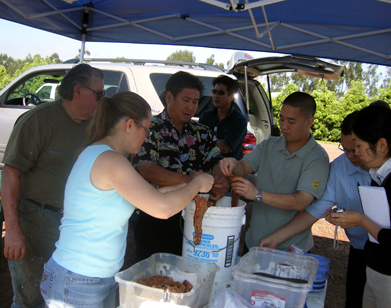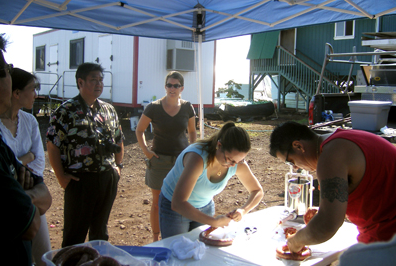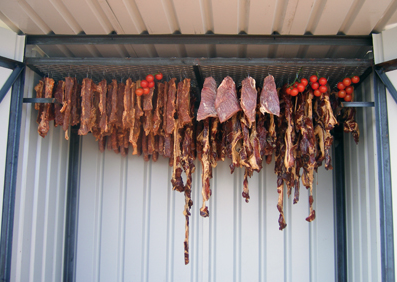Richard Ha writes:
Chef Alan Wong visited the farm recently. He was taking his chefs and other personnel from his restaurants on a tour of Hamakua farming operations. They visited farmers whose products they use in their restaurants.
We knew Alan was interested in seeing how Portuguese sausage was made, traditional style. And he was interested in seeing how to make smoked meat and pipikaula, so I asked Kimo if he would demonstrate.
Tracy and Kimo stuffing sausages; that’s Alan Wong and Charlotte Romo observing
Kimo said yes, and he made a portable smoke house at the farm. He had it built in a flash with iron, a steel frame and some iron roofing we had around. They used ‘ohi‘a wood for the fire.
Over the weekend, Tracy marinated the meat and stuffed most of the sausage. Before when people used to hang meat in a smoke house, they would use iron, or a piece of hanger, that they bent with a hook on the end. But nowadays they use large paper clips. Kimo said, “You can tell—the guy wearing camouflage clothing who walks into Office Max looking for paper clips and looking lost, he’s a hunter and it’s probably the last time he ever goes into Office Max.”

Attaching meat to the paper clips
Alan Wong was right in there with his hands, putting the paper clips on the meat. He jumped right in.
We smoked pig—the long strips in the front are the pork—and Portuguese sausage, which is behind. We also smoked tomatoes and some of our jalapeno peppers.
Kimo learned how to do all this from Alvin Jardine, who’s on the right (below). He’s Kimo’s mentor in terms of stuff like this. We’ve known Alvin for about 14 years. He used to come and trap pigs at the Kea‘au farm. He must have caught hundreds of pigs over those 14 years. Now he has about 50 wild pigs at his place.
Kimo with Alvin Jardine
Sometimes they dig out under the fence, but he feeds them so well the wild pigs always come back at night. He waits until it’s dark at night and they’re home, and then he fixes the fence. He starting working at the sugar plantation when he was 14 years old—he plowed the fields with a mule and plow. He’s been hunting since then and is still hunting today.
He spoke to our guests and gave pointers about preparing meat for sausage. It was interesting to listen to him. One of the people asked how much salt you use and he said, “Just enough.” The guy asked, “But how much?”
Alvin said it again, “Just enough.” I glanced over at Alan Wong and he had this big grin on his face because he understood exactly what Alvin was saying.
Kimo lit the ‘ohi‘a logs with a propane torch and in five minutes they were ready to go. We took everybody on a farm tour, and when we got back to the smokehouse the meat was already ready to taste.
Smoking meat is really second nature to Kimo and Tracy. They do it so often. I was happy to see that everybody got to see it through the whole process. It was real fun because it was something different.



